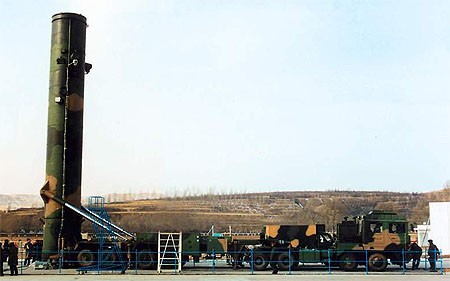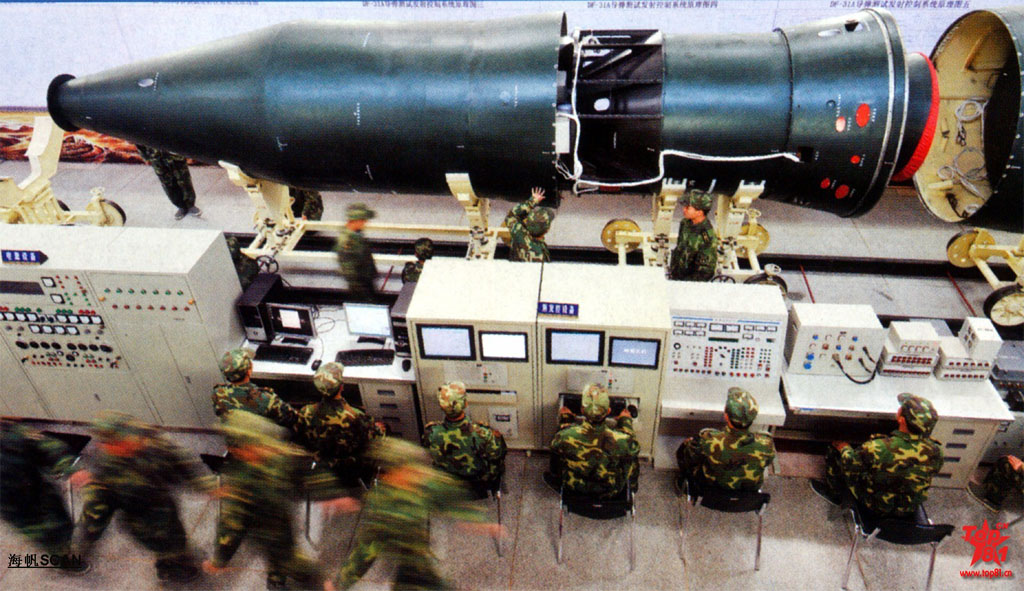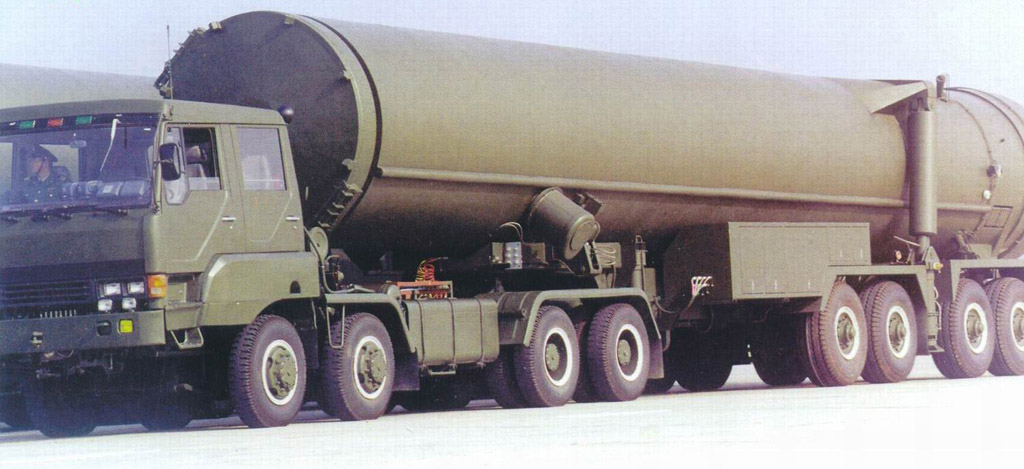| DongFeng 31A (CSS-9 Mod-2) Intercontinental Ballistic Missil
中国DF-31A(CSS-9 Mod-2)洲际弹道导弹 Date:2016-01-04 Source:internet By:globalmil Viewed: |

The DongFeng 31A (NATO reporting name: CSS-9 Mod-2) is a road-mobile, three-stage, solid-propellant intercontinental ballistic missile (ICBM), designed to carry a single 1,000kT thermal nuclear warhead. The missile was developed from the DongFeng 31 (CSS-9), with extended range and improved performance. About 10 DongFeng 31A missiles have been deployed by the PLA Second Artillery Corps since 2006~07 to supplement its silo-based DongFeng 5 (CSS-4) ICBM. A submarine-launched ballistic missile JuLang 2 is also being developed based on the DongFeng 31 technology.
东风-31A(北约:CSS-9 Mod-2)是一种公路机动、三级、固体推进剂洲际弹道导弹(ICBM),设计携带单一1,000 kT热核弹头。导弹基于东风-31(CSS-9)发展,具有增加射程和改进性能。大约10枚东风-31A导弹从2006~07年以后被PLA第二炮兵部署去补充它的发射井-基东风-5(CSS-4) ICBM。潜射弹道导弹巨浪-2也正在基于东风-31技术发展。
The DongFeng 31A offers a number of technological and operational advantages over older Chinese missiles such as DF-4 (CSS-3). Instead of being launched from a fixed location, the DongFeng 31A can be transported on its transporter-erector-launcher (TEL) vehicle to one of many predetermined launch sites, giving greater survivability in the event of a first strike. The use of solid propellant gives the missile a longer service lifespan and shorter launch preparation time compared to the liquid fuel ICBMs.
东风-31A和中国旧型号导弹例如DF-4(CSS-3)相比呈现许多技术上和操作上的优势。不再从固定位置发射,东风-31A装载在一辆竖立式运输发射架(TEL)车上到许多预定发射位置的其中之一,在面临第一波攻击时具有极强的生存性。导弹与液体燃料ICBM相比采用固体推进剂具有较长的服役寿命和较短的发射准备时间。
The DongFeng 31A is said to be armed with a lightweight warhead allegedly copied from the U.S. W-88 or W-70 warhead designs, though so far no sound evidence has been found to support this claim. Furthermore, the DongFeng 31A is believed to have incorporated many advanced technologies similar to current generation Russian ICBMs, including the use of penetration aids such as decoys or chaffs to complicate enemy’s missile warning and defence system.
东风-31A装备一种轻型弹头据传闻仿制美国的W-88或W-70弹头设计,然而到目前为止没有发现足够的证据支持这一个断言。此外,东风31A据信已经吸收许多先进技术和现阶段俄国ICBM类似,包括采用突防手段像诱饵或金属箔条去干扰敌人导弹告警和防卫系统。

DongFeng 31A launch test (Chinese Internet).东风-31A发射测试(中国英特网)
Programme
The DongFeng 31 programme began in 1986, originally intended as a successor to the DF-4 (CSS-3) intermediate-range ballistic missile (IRBM) to cover targets in the European theatre of the Soviet Union. The design task was assigned to the 4th Department (Solid-Propellant Missile Design Department, now part of the CASIC 4th Academy). The solid-propellant rocket motors used on the first- and second-stage of the DongFeng 31 were successfully tested in late 1983. The third-stage rocket motor was tested in mid-1984. The programme entered the engineering development phase in 1987.
计划
东风-31计划从1986年开始,最初构想当作一种DF-4(CSS-3)中程弹道导弹(IRBM)去覆盖包括苏联在欧洲地区的目标。设计工作分配给第4空间研究院(固体推进剂导弹设计部门,现在中国航天科技集团公司第四研究院(航天动力技术研究院)的部分)。在东风-31导弹第一级和第二级使用的固体推进剂火箭发动机成功地在1983年后期进行测试。第三级火箭发动机1984年测试。在1987年计划进入工程发展阶段。
The first test launch of the missile using a dummy warhead was conducted on 2 August 1999, from Taiyuan missile test facility (known as Wuzhai Missile Test Centre) in Shanxi Province to the impact zone in Lop Nor in Xinjiang. The test was only partially successful. The DongFeng 31 missile system was briefly displayed during the 1999 National Day military parade, though the missile itself could not be seen as it was concealed in the large canister carrier on a truck-trailer transport-erection-launch (TEL) vehicle. Two further tests were carried out in late 2000, but they were said to be also unsuccessful.
在1999年8月2日导弹采用一枚模拟弹头进行第一次试射,从陕西省太原(Taiyuan)导弹试验基地(即五寨导弹测试中心)到新疆罗布泊撞击地点。测试仅部分成功。东风-31导弹系统短暂地在1999年国庆阅兵式上展示,但被隐藏起来导弹它本身不能被看到,实际上储藏在一个大型发射筒内装载在一辆载重(TEL)车辆上。在2000年进行了两次进一步的测试,但是它们据说也没有成功。
The DongFeng 31 was originally developed in parallel with the 12,000km-range DF-41 (CSS-X-10) ICBM. However, the end of the Cold War and a review of China’s nuclear strategy resulted in the DF-41 being cancelled in the late 1990s, leaving DongFeng 31 China’s only active ICBM programme. However, with its maximum range of 8,000km, the DongFeng 31 was regarded inadequate to provide an effective nuclear deterrent. For example, when launched from central China, the missile could only reach a smaller corner of the west coast of the United States. This limitation, coupled with various design flaws and technical issues, led to the decision to develop an improved variant DongFeng 31A, which caused further delay in the operational deployment of the missile. A flight test of the DongFeng 31A was carried out on 4 September 2006, and the test was said to be fully successful.
东风-31最初和12,000公里-射程的DF-41(CSS-X-10) ICBM平行发展。然而,冷战结束和中国核战略调整造成DF-41在1990年后期被取消,留下中国唯一进行的东风-31 ICBM计划。尽管,它最大射程8,000公里,东风-31被视为提供一种不充分的核扼制能力。举例来说,当从中国中部发射,导弹只能到达美国西海岸的一个小范围区域。这个限制,加上各种不同的设计缺陷和技术问题,导致决定发展一种改进的东风-31A,引发导弹操作部署进一步的延迟。在2006年9月4日东风-31A进行一次飞行测试,而且测试据说完全成功。
The 2007 U.S. Department of Defense (DOD) report to congress on the PRC military power suggested that the DongFeng 31 had reached “initial threat availability (ITA)” in 2006 and possible “operational status by May 2007”. The 2008 version of the report confirmed that less than 10 DongFeng 31A missiles/launchers were being deployed by units within the PLA Second Artillery Corps.
2007年美国防部对国会作的中国军事力量报告称东风-31在2006年已经达到“初始有效威胁(ITA)”和可能“2007年5月处在操作状态”。2008年版本报告确认不超过10牧东风-31A导弹/发射装置在PLA第二炮兵内的单位部署。

DongFeng 31A third-stage (PLA Pictorial).东风-31A 第三级(解放军画报)
Design
It was estimated that the DongFeng 31A had a payload of about 700kg (other source suggested between 1,050 and 1,750kg), which can be equipped with a single 1,000kT yield nuclear warhead. The maximum range of the missile is 10,700~11,200km. The missile uses an inertial guidance system that is equipped with a stellar update system, and is expected to have an accuracy of at least 300m CEP. Some resource suggested that the silo and TEL-based versions of the DongFeng 31A have 100m and 150m CEP respectively.
设计
一般估计东风-31A负载大约700公斤(其它消息来源称在1,050公斤和1,750公斤之间),能装备一枚单一1,000 kT当量核弹头。导弹最大射程是10,700~11,200公里。导弹采用一套装备星形修正的惯性导航系统,而且预料CEP精度不超过300米。一些消息来源认为发射井和TEL-基东风-31A分别具有100米和150米CEP。

DongFeng 31A TEL vehicle (Chinese Internet).东风-31A TEL车辆(中国英特网)
The road-mobile DongFeng 31A is carried inside a large canister launcher mounted on a 16-wheeled HY473 or HY4301 TEL consisting of a tractor and a semi-trailer. The TEL vehicle appeared to be only suitable for road travelling, with little, if any, off-road travelling capability. A new single 12- or 16-wheeled TEL similar to those used by the Russian ICBM systems is reportedly in development. There has been speculation that China was also developing a railway-based TEL for the DongFeng 31 but this cannot be confirmed.
公路-机动东风-31A储藏在一个大型发射筒内装载在一辆16-轮 HY473型或HY4301型由一辆牵引卡车和一辆半-拖车组成的TEL平台上。TEL车辆似乎仅仅适合用于公路行进,如果真具有的话,可能具有少许越野行进能力。新的单辆12-或16-轮TEL与俄国ICBM采用的系统类似据传闻正在发展中。已经推测中国也发展铁路-基TEL用于东风-31但不能够被确认。
Units
·806 Brigade
·812 Brigade
·813 Brigade
单位
·806 旅
·812 旅
·813 旅
Specifications
Official name: DongFeng 31A (DF-31A)
NATO reporting name: CSS-9 Mod-2
Contractor: CASIC 4th Academy
Service status: In service
Configuration: Three-stage, solid propellant
Deployment: Road mobile, 8X8 tractor truck + 8-wheel trailer; or silo
Length: 13m
Body diameter: 2.25m
Launch weight: 42,000kg
Range: 10,700~11,200km
Re-entry vehicle mass: 700kg (or 1,050~1,750kg)
Warhead: One single 1,000kT yield
Guidance: Inertial + stellar update
Accuracy: 100~300m CEP
Launch preparation time: 15~30 min
规格
正式命名: 东风-31A(DF-31A)
北约组织代号: CSS-9 Mod-2
承包商: 中国航天科技集团公司第四研究院(航天动力技术研究院)
服役状态: 服役中
结构: 三-级,固体推进剂
配置: 公路机动,8X8 牵引卡车 + 8轮拖车;或发射井
长度: 13 米
弹体直径: 2.25 米
发射重量: 42,000 公斤
射程: 10,700~11,200 公里
再入运载器质量: 700 公斤(或 1,050~1,750 公斤)
弹头: 一枚单一 1,000 kT 当量
制导: 惯性 + 星形修正
精度: 100~300 米 CEP
发射准备时间: 15~30 分钟
Last update: 15 February 2009
最后更新:2009年2月15日
上一篇:DongFeng 31 (CSS-9) Intercontinental Ballistic Missile 下一篇:DongFeng 41 (CSS-X-10) Intercontinental Ballistic Missile
| DF-1 ballistic missile system
中国东风-1(DF-1)弹道导弹系统 |
| China’s first ballistic missile system, a licensed copy of the Soviet R-2 (SS-2 ‘Sibling’) short-range ballistic missile.... [2020-04-05] |
| B611 TACTICAL SURFACE-TO-SURFACE BALLISTIC MISSILE
中国B611战术地对地弹道导弹 |
| The B611 is the solid-fuel, surface-to-surface, short-range ballistic missile (SRBM) jointly developed by China Aerospace Science & Industry Corporation (CASIC) and Turkish weapon manufacturer MKEK.... [2017-01-15] |
| DF-21/A/C(CSS-5 Mod1/2/3)medium-range ballistic missile
中国东风-21/A/C型中程弹道导弹 |
| The DF-21 is a two-stage, solid-fuel rocket, single-warhead medium-range ballistic missile (MRBM) in the Dong Feng series developed by China Changfeng Mechanics and Electronics Technology Academy.... [2016-08-17] |
| DongFeng 31A (CSS-9 Mod-2) Intercontinental Ballistic Missil
中国DF-31A(CSS-9 Mod-2)洲际弹道导弹 |
| The DongFeng 31A (NATO reporting name: CSS-9 Mod-2) is a road-mobile, three-stage, solid-propellant intercontinental ballistic missile (ICBM), designed to carry a single 1,000kT thermal nuclear warhead.... [2016-01-04] |
